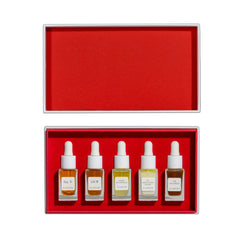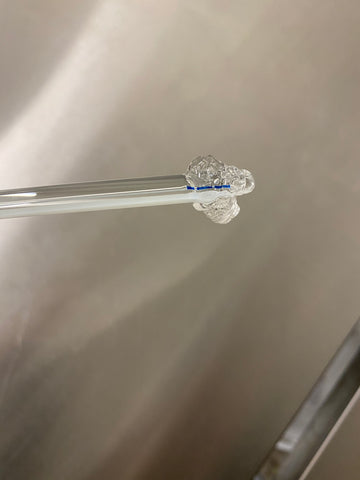Materials used in this experiment:
Experimental methods and results
The first part of the experiment, I went right to the claim that hyaluronic acid absorbs 1000x its weight in water. I weighed out 1g of HA for all molecular weights (HMW, HLW, HSLMW, HULMW) and placed this in 1000g of distilled water.

Pictured here is 1g of HA and 1000g of water (quarter shown for scale). As you can see it is a bold claim to state that such a small amount of HA can absorb that much water. Experimentally, this would mean that the HA would turn the water into a thick gel when added. This did not happen.
I then let the mixture sit for two days to allow for total absorption to occur.
After two days the mixture looked no different than regular water. There was no discernible change in thickness. I filtered out the mixture to determine if any gel had formed, indicating absorption and no gel was obtained.
This means that hyaluronic acid did not absorb 1000x its weight in water. It did not even come close enough to that figure to be measured.
I repeated the above protocol for 500x HA's weight in water, 250x its weight in water and 100x its weight in water. At 100x its weight in water, there was some thickening of the water for HMW, HLW and HSLMW, but not for HULMW. These findings indicate that HA was beginning to show saturation, but this is 10x less than the claims of 1000.
When HMW was put in 50x its weight in water, a semi-thick gel (hair-gel consistency) formed. However, this was not how HA is supposed to look when fully saturated, indicating it was not able to fully absorb 50x its weight in water. Therefore I had to add less water to the mixture to determine HA's saturation point.
Gel pictured here formed at 50x weight in water, however the thinness of the gel indicated that HA was not able to fully absorb all of the water in its environment.
The next step was to put HMW in 10x its weight in water. It was at this point that I believed a fully saturated gel had formed. This gel was dense. It was only at this time that gel clumps were formed.
This gel, obtained by putting HA in 10x its weight in water had the thickness consistent with fully saturated hyaluronic acid.
Hyaluronic acid of low molecular weights did not properly form gels, indicating they were not as efficient at gelling compared to high molecular weight HA.
This experiment told me that hyaluronic acid does not hold 1000x its weight in water, but it also told me something far more important. This experiment told me that there isn't an established scientific protocol for determining how much water hyaluronic acid is capable of absorbing. There was a varying degree in the thickness of the gels depending on how much water was added, and there wasn't a point in any of the experiments where I could subjectively and definitively determine where hyaluronic acid was fully saturated. A gel only started to form around the 50x its weight point, and the gel seemed to be fully saturated only around the 10x its weight point. The problem here is that it is fully up to the researcher to give a ballpark estimate based on their own perception to determine how much of hyaluronic acids weight it is actually able to absorb in water. That means that the science behind hyaluronic acid's absorption claims is somewhat dubious.
At the end of the day, it does not really matter how much water hyaluronic acid can absorb, from a skin care standpoint, because it is an ingredient that should be avoided due to its drying effect. It doesn't absorb into the skin and plump it, so who cares if it can absorb 10x its weight or 1000x its weight. Its all meaningless.
But what does matter is that a claim that has been parroted by every skin care company who uses it is completely false. And whats worse is that unsubstantiated hearsay is being passed off as scientific, and is repeated so often people take it at face value without any further research. None of these companies did their own research to back up the claim. They just repeated it and deceived everyone. Nothing about that is scientific.
It is about time that the real science stands up.

UPDATE: 2022 Follow Up Study
Low molecular weight hyaluronic acid cannot hold its own weight in water






